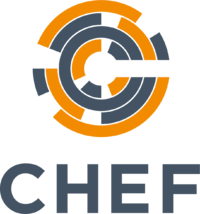Chef
Topic: Software
 From HandWiki - Reading time: 4 min
From HandWiki - Reading time: 4 min
 | |
| Developer(s) | Chef |
|---|---|
| Initial release | January 2009[1] |
| Stable release | |
| Repository | github |
| Written in | Client: Ruby Server: Ruby, Erlang |
| Operating system | Linux, MS Windows, FreeBSD, macOS, IBM AIX, Solaris |
| Type | Configuration management, System administration, Network management, Cloud management, Continuous delivery, DevOps, Infrastructure as Code |
| License | Apache License 2.0 |
| Website | www |
Chef is a company and the name of a configuration management tool written in Ruby and Erlang. It uses a pure-Ruby, domain-specific language (DSL) for writing system configuration "recipes". Chef is used to streamline the task of configuring and maintaining a company's servers, and can integrate with cloud-based platforms such as Amazon EC2, Google Cloud Platform, Oracle Cloud, OpenStack, IBM Cloud, Microsoft Azure, and Rackspace to automatically provision and configure new machines. Chef contains solutions for both small and large scale systems, with features and pricing for the respective ranges.
Features
The user writes "recipes" that describe how Chef manages server applications and utilities (such as Apache HTTP Server, MySQL, or Hadoop) and how they are to be configured. These recipes (which can be grouped together as a "cookbook" for easier management) describe a series of resources that should be in a particular state: packages that should be installed, services that should be running, or files that should be written. These various resources can be configured to specific versions of software to run and can ensure that software is installed in the correct order based on dependencies. Chef makes sure each resource is properly configured and corrects any resources that are not in the desired state.[4]
Chef can run in client/server mode, or in a standalone configuration named "chef-solo". In client/server mode, the Chef client sends various attributes about the node to the Chef server. The server uses Elasticsearch to index these attributes and provides an API for clients to query this information. Chef recipes can query these attributes and use the resulting data to help configure the node.[citation needed]
Traditionally, Chef was used to manage Linux but later versions support Microsoft Windows as well.[5]
It is one of the major configuration management systems on Linux, along with CFEngine, Ansible and Puppet.[6][7] More than a configuration management tool, Chef, along with Puppet and Ansible, is one of the industry's most notable Infrastructure as Code (IAC) tools.[8]
History
Chef was created by Adam Jacob as a tool for his consulting company, whose business model was to build end-to-end server/deployment tools. Jacob showed Chef to Jesse Robbins, who saw its potential after running operations at Amazon. They founded a new company with Barry Steinglass, Nathen Haneysmith, and Joshua Timberman to turn Chef into a product.[9]
The project was originally named "marionette", but the word was too long and cumbersome to type; the "recipe" format that the modules were prepared in led to the project being renamed "Chef".[9]
In February 2013, Opscode released version 11 of Chef. Changes in this release included a complete rewrite of the core API server in Erlang.[10]
On April 2, 2019, the company announced that all their products are now open source under the Apache 2.0 license.[11]
On September 8, 2020, Progress announced the acquisition of Chef.[12]
Platform support
Chef is supported on multiple platforms according to a supported platforms matrix for client and server products.[13] Major platform support for clients includes AIX, Amazon Linux, Debian, CentOS/RHEL, FreeBSD, macOS, Solaris, SUSE Linux, Microsoft Windows and Ubuntu. Additional client platforms include Arch Linux and Fedora. Chef Server is supported on RHEL/CentOS, Oracle Linux, SUSE Linux and Ubuntu.
Customers
Chef is used by Facebook,[14] AWS OpsWorks, Prezi,[15] and BlackLine.
See also
- Comparison of open-source configuration management software
- Infrastructure as code (IaC)
- Infrastructure as Code Tools
- Ansible
- DevOps
- DevOps toolchain
- Otter (software)
- Puppet
- Salt
- Juju
References
- ↑ "Announcing Chef". chef.io. 15 January 2009. https://blog.chef.io/announcing-chef/. Retrieved 2021-05-24.
- ↑ "Chef Infra Server 14.4.4 Released! - Chef Release Announcements - Chef Questions". https://discourse.chef.io/t/chef-infra-server-14-4-4-released/19894.
- ↑ "Chef Infra Client 17.1 Released! - Chef Release Announcements - Chef Questions". https://discourse.chef.io/t/chef-infra-client-17-1-released/19876.
- ↑ Chef - Code Can | Chef, https://www.chef.io/, retrieved 2015-07-04
- ↑ Cade Metz (2011-10-26), "The Chef, the Puppet, and the Sexy IT Admin", Wired, https://www.wired.com/2011/10/chef_and_puppet/, retrieved 2015-07-04
- ↑ Alan Sharp-Paul (2013-03-04), Puppet vs. Chef - The Battle Wages On, http://www.scriptrock.com/blog/puppet-vs-chef-battle-wages, retrieved 2015-07-04.
- ↑ Lueninghoener, Cory (2011-03-28), "Getting Started with Configuration Management", ;login: (Usenix) 36 (2), https://www.usenix.org/system/files/login/articles/105457-Lueninghoener.pdf, retrieved 2015-07-04
- ↑ Keiser, John (14 November 2016). "Chef Provisioning: Infrastructure As Code". https://www.chef.io/blog/2014/11/12/chef-provisioning-infrastructure-as-code/.
- ↑ 9.0 9.1 History of Chef: What's in a Name? on YouTube
- ↑ Bryan McLellan (2013-02-04). "Chef 11 Released!". Chef. https://www.chef.io/blog/2013/02/04/chef-11-released/. Retrieved 2015-07-04.
- ↑ Introducing the New Chef: 100% Open, Always - Chef Blog
- ↑ Corporation, Progress Software (2020-09-08). "Progress Announces Acquisition of Chef". http://www.globenewswire.com/news-release/2020/09/08/2089870/0/en/Progress-Announces-Acquisition-of-Chef.html.
- ↑ "Platforms — Chef Docs". chef.io. https://docs.chef.io/supported_platforms.html. Retrieved 2 April 2021.
- ↑ "Facebook uses a seasoned Chef to keep servers simmering". pcadvisor.co.uk. http://www.pcadvisor.co.uk/news/software/3495788/facebook-uses-a-seasoned-chef-to-keep-servers-simmering/. Retrieved 6 January 2014.
- ↑ How Chef Enables the DevOps Culture at Prezi - Zsolt Dollenstein on YouTube
External links
 KSF
KSF
